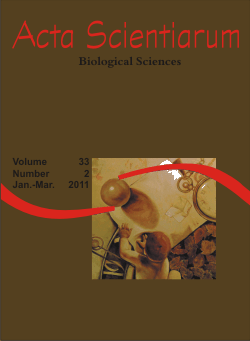<b>Toxic effects of phytosanitary surfactants for jewel tetra (<em>Hyphessobrycon eques</em>)</b> - doi: 10.4025/actascibiolsci.v33i2.6252
Keywords:
Ecotoxicology, fish, water quality, behavior
Abstract
Surfactants are amphipatic molecules that reduce the surface tension of water and make up the inert components of pesticide formulations. Thus, the objectives of this study were: to estimate the lethal concentration (LC(I)50;96h); classify and evaluate water quality during testing of the following surfactants: Agral®, Aterbane®BR, Ag-bem®, Energic®, Fixade® and Gotafix® for jewel tetra (Hyphessobrycon eques); and the signs of intoxication in the animals. For this, the fish were acclimated for ten days in the bioassay room. The animals were exposed to the surfactants in an entirely randomized design with three replications. The LC(I)(50;96h) of surfactant Agral® was 3.29 mg L-1; Aterbane® BR 8.21 mg L-1; Energic® 2.34 mg L-1; Gotafix® 4.37 mg L-1; Fixade® 3.38 mg L-1; and Ag-bem® 34.95 mg L-1. The variables of water quality were unchanged. The fish showed an increase in the opercular beating after exposure; 4 and 24 hours, loss of gasping ability; 48 hours, slow opercular beating; and 72 and 96 hours later, recovery. The surfactants Energic®, Agral®, Gotafix®, Aterbane® BR and Fixade® can be classified as moderately toxics, and Ag-Bem® as slightly toxic for H. eques; this organism shows similar intoxication signs for all surfactants.Downloads
Download data is not yet available.
Published
2011-02-08
How to Cite
Carraschi, S. P., Cubo, P., Schiavetti, B. L., Shiogiri, N. S., Cruz, C. da, & Pitelli, R. A. (2011). <b>Toxic effects of phytosanitary surfactants for jewel tetra (<em>Hyphessobrycon eques</em>)</b> - doi: 10.4025/actascibiolsci.v33i2.6252. Acta Scientiarum. Biological Sciences, 33(2), 191-196. https://doi.org/10.4025/actascibiolsci.v33i2.6252
Issue
Section
Ecology and Limnology
DECLARATION OF ORIGINALITY AND COPYRIGHTS
I Declare that current article is original and has not been submitted for publication, in part or in whole, to any other national or international journal.
The copyrights belong exclusively to the authors. Published content is licensed under Creative Commons Attribution 4.0 (CC BY 4.0) guidelines, which allows sharing (copy and distribution of the material in any medium or format) and adaptation (remix, transform, and build upon the material) for any purpose, even commercially, under the terms of attribution.
Read this link for further information on how to use CC BY 4.0 properly.
0.6
2019CiteScore
31st percentile
Powered by 

0.6
2019CiteScore
31st percentile
Powered by 











1.png)




3.png)













